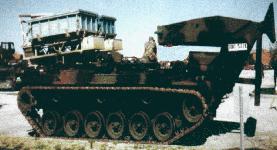



The M60 Armored Vehicle Launched Mine Clearing Line Charge (MICLIC) [AVLM] is an M60 Armored Vehicle Launched Bridge (AVLB) with the bridge downloaded. Mounting up to 2 MICLICS, it is more survivable and maneuverable than the M58 MICLIC towed trailer. The modification of the AVLB into an AVLM is a temporary expedient. The decision to operate as an AVLM in no way eliminates the responsibility of maintaining a fully operational AVLB.Engineers use it to clear a path through obstacles without having to dismount. The MICLIC must be prepared for firing before it is moved forward for deployment. This preparation time will minimize soldiers' exposure to enemy contact.
One of the most dangerous tasks an engineer squad can face is dismounting and breaching a minefield under fire. Each lane reduction elements is built around an engineer platoon that has been reinforced with a plow/roller tank, an AVLM, and a Bradley Squad. An engineer platoon may use a pair of MICLICs as the primary technique to breach a minefield. The AVLMs take up a position 15-20 meters behind or to the side of the lead tank and fires one of its two MICLICs. As soon as the engineer platoon fires the second MICLIC, the engineer squads employ manual explosive techniques to push additional lanes through the minefield. The lanes are spaced at least 100 meters apart to reduce artillery effects. The MICLIC firings will attract enemy artillery fires to the lane location, minimizing risk to the dismounted breach squads. If plow tanks are available, they would be plowing lanes either alongside or in place of the dismounted engineer squads. The infantry squads provide local security throughout the operation. Roller/plow tanks move up and detect the forward edge of the mine fields and back off 50 meters providing near side security. Engineer squads towards the rear of the formation place far recognition signals to guide follow-on units into lanes. Each lane is individually designated either by color or number to control movement through the breach. Conducting the breach with a MICLIC towed by a squad M113 not only exposes the squad to fires in a lightly armored vehicle but also presents the possibility of losing two breaching assets at the enemy minefield. The loss of two breaching assets can also occur if the AVLM is used. Commanders and engineers must consider the risk of losing sappers and other breach assets when planning for breaching operations. The MICLIC system suffered from several serious shortcomings during the Gulf War. Engineer after-action reports from Desert Storm concluded that units placed an over-reliance on the MICLIC as the answer to all their breaching problems. This was due to the ignorance of threat mine capabilities, poor MICLIC training at home station, and the general lack of an effective training device or training strategy. During test firings the system suffered a 50-percent failure rate.The Mine-Clearing Line Charge (MICLIC) is a critical mobility asset-even with its limitations:
- The MICLIC line charges sink due to settling, which may cause them to deploy erratically and/or misfire.
- Some rockets come unlocked, due to excessive stress on the launcher rail, while traveling across rough terrain with the rocket attached to the MICLIC launcher.
- Excessive speed may require that the MICLIC spend more time at the assault position rather than moving quickly forward to fire.
Even when the MICLIC fires successfully, it can only clear a 100-meter-long path in an obstacle. This is excellent for small obstacles, but not for the deep obstacles found in many breaching operations. The MICLIC has a "skip zone," where mines are left untouched. Also, deeply buried mines, nonpressure-fuse mines, and overpressure-resistant mines are very resilient against the MICLIC.
